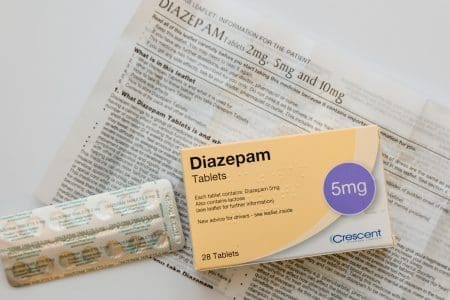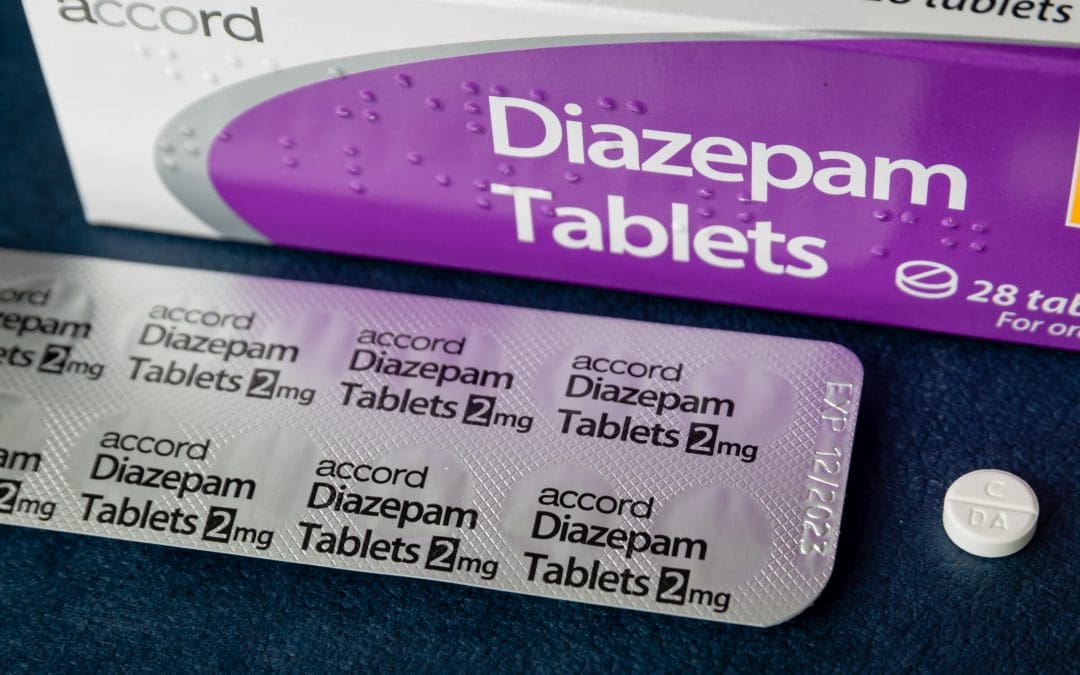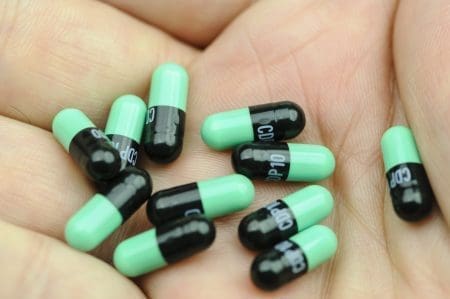Valium, the trade name for diazepam, is synonymous with the treatment of anxiety and the management of alcohol withdrawal symptoms. But can you overdose on Valium?
This medication, a cornerstone of the benzodiazepine class, has been a mainstay in medicine cabinets around the world, providing relief to those suffering from spasms, seizures, and the jitters of nerves gone haywire.
However, its potent therapeutic effects are a double-edged sword; misuse can lead to a dangerous path toward diazepam overdose.
Recognizing the thin line between treatment and toxicity is crucial, particularly when the boundary between a therapeutic and a lethal dose of valium is so fine.
This comprehensive guide delves deep into the world of Valium, unfolding its uses, dosage guidelines, and the red flags of overdose that warrant immediate attention.
What is Valium (Diazepam)?

Valium was one of the early benzodiazepines, coming out at a time when doctors were looking for medicines that could help with anxiety and seizures without being too risky.
Valium was developed by a company called Hoffmann-La Roche over fifty years ago, and it quickly became well-known. It was one of the first drugs of its kind, known as benzodiazepines, which were introduced to help people manage stress and anxiety.
These drugs are special because they work on the brain and nerves to help relax the body, ease tension, and prevent seizures without being as risky as older medications.
What are benzodiazepines?
Benzodiazepines, sometimes known as “benzos,” are a class of psychoactive drugs that have a tranquillizing effect on the brain and central nervous system. They function by enhancing the effect of the neurotransmitter GABA (gamma-aminobutyric acid), which results in sedative, hypnotic (sleep-inducing), anxiolytic (anti-anxiety), anticonvulsant, and muscle relaxant properties.
Benzodiazepines are prescribed for a range of conditions, such as anxiety, insomnia, seizures, and muscle spasms. Some of the well-known benzodiazepines, besides Valium (diazepam), include Xanax (alprazolam), Ativan (lorazepam), and Klonopin (clonazepam).
All these medicines work in similar ways to help people feel calm and stop seizures. However, they’re different in how strong they are, how long they work, and the exact reasons doctors might prescribe them. They’re used often because they help with many health issues, but they can also be habit-forming and cause withdrawal symptoms if stopped suddenly. That’s why it’s important for doctors to watch closely how they’re used.
Is Valium a Narcotic?
Valium is not classified as a narcotic. The term “narcotic” originally referred to any psychoactive compound with sleep-inducing properties, but in the legal and medical fields, it has come to be associated specifically with opioids—substances derived from opium or synthetic analogs with similar effects, such as pain relief.
Valium, on the other hand, is a benzodiazepine, which is a category of drugs that includes sedatives used primarily for treating anxiety, insomnia, and seizures. It is still a controlled substance due to its potential for abuse and dependence.
The Development of Valium
Valium was one of the early benzodiazepines, coming out at a time when doctors were looking for medicines that could help with anxiety and seizures without being too risky.
Before Valium, doctors often used drugs called barbiturates, but these could be dangerous because they were very strong and people could easily become dependent on them. Barbiturates can also cause serious problems if taken in large amounts.
When Valium came along, it offered a safer option. It worked well but with less risk of addiction and overdose compared to barbiturates. This made Valium a better choice for many patients, which is why doctors started to prescribe it more.
The Pharmacodynamics of Valium
To fully comprehend the risk of a diazepam overdose, it’s essential to understand Valium’s mechanism of action.
Valium works by boosting a brain chemical called GABA. Think of GABA like the brain’s volume knob — it helps turn down the noise of the brain’s activity. When Valium increases GABA, it’s like lowering the volume, which calms the brain down.
This neurotransmitter is the brain’s brake pedal, and Valium’s enhancement of GABA’s effects leads to a reduction in anxiety, a halt in seizure activity, and muscle relaxation.
Intended Uses of Valium
Valium as a Defense Against Anxiety
Valium’s primary indication is the treatment of anxiety disorders, a group of mental health conditions marked by overwhelming, incessant worry and fear.
When someone is having an anxiety attack, Valium works quickly to bring calmness. It provides a break from the intense worry and fear that come with anxiety.
Valium’s Place in Alcohol Recovery
When someone who often drinks a lot of alcohol suddenly stops, their body can have a hard time adjusting — it’s like the body is rebelling. This is where Valium can help. It acts like a strong defender, helping to control the dangerous symptoms that can happen when a person stops drinking.
These symptoms can be different for everyone but might include trouble sleeping, feeling very restless or shaky, having seizures, or experiencing severe confusion and changes in thinking. Valium helps keep these symptoms in check, making it safer for people to get through the tough early days of not drinking.
Beyond Anxiety: The Versatile Prescribing of Valium
While anxiety and alcohol withdrawal are its headliners, Valium’s therapeutic roles extend further. It’s used to relax muscles, control convulsive disorders, and can even be administered before certain medical procedures to reduce tension and anxiety.
The Link Between Anxiety, Alcohol Withdrawal, and Valium Use
Anxiety and alcohol withdrawal interact with similar parts of the brain, and that’s why Valium can be so helpful for both. People with long-term anxiety can have brains that are always on high alert, while stopping heavy drinking suddenly can make the brain act out because it misses the chemicals that alcohol used to give it.
Valium steps in by boosting GABA, the brain chemical that helps calm things down. This can be a big help when someone is going through the tough times that come with anxiety or stopping alcohol.
But using Valium needs to be done carefully. It works well, which is why it’s often used for anxiety and helping people through withdrawal, but it can also be habit-forming. If it’s not used the right way, there’s a risk of getting too dependent on it, or even ending up with an overdose on diazepam.
Valium is powerful, and figuring out how much Valium is too much isn’t always simple. It depends on how each person’s body reacts to it, how often they take it, and whether they’re using other drugs or alcohol at the same time.
Can You Overdose on Valium?
Recognizing the Signs of Valium Use
Valium’s presence in the body is often marked by a distinct softening of the harsh edges of anxiety or withdrawal. In therapeutic doses, this manifests as a gentle easing of tension, a quieting of the mind’s incessant chatter, and a release from the grip of muscular spasms. However, these desired effects can also veil the signs of misuse.
When use turns to misuse, the signs become more pronounced. There may be slurred speech, a noticeable lack of coordination, and a drowsiness that edges into stupor or profound sedation. Understanding and recognizing these signs are essential, particularly as the line between use and misuse can often be as subtle as it is dangerous.
How Much Valium Is Too Much?
Deciding how much Valium to take needs to be very exact. People with anxiety usually need smaller doses, but someone dealing with stopping drinking might need more. But figuring out how much Valium is too much isn’t just about the number of milligrams. It’s also about things like how much you weigh, how fast your body processes drugs, if you’ve taken benzodiazepines before, and if you’re taking other medicines or drugs.
Taking too much Valium can be very dangerous. What’s safe for one person might be too much for another, which is why it’s so important to follow a doctor’s advice.
The line between the right dose and too much can be very thin, and making a mistake with how much you take can have serious results. If someone does take too much, doctors have to act fast with a diazepam antidote to help stop the overdose from getting worse.
Flumazenil – The Diazepam Antidote
Flumazenil is a benzodiazepine antagonist, which means it can reverse the effects of benzodiazepines like diazepam. It works by blocking the action of benzodiazepines on the GABA receptors in the brain, which are the same receptors that diazepam acts upon to exert its effects.
Flumazenil is used in emergency situations when there is a suspected benzodiazepine overdose, but it must be administered under medical supervision because it can cause withdrawal symptoms and seizures in individuals who are dependent on benzodiazepines.
Symptoms of a Valium Overdose
The symptoms of a Valium overdose can be deceptive in their onset, often resembling an intensification of the drug’s therapeutic effects. However, as the overdose progresses, these symptoms can escalate to life-threatening levels.
Valium overdose symptoms include severe drowsiness, confusion, diminished reflexes, and respiratory depression. In severe cases, an overdose may lead to unconsciousness, coma, or even death.
The central nervous system depression that Valium induces can suppress vital bodily functions, particularly breathing, to a point of critical failure. Recognizing these symptoms is a race against time, where every moment counts in preventing irreversible harm.
Preventing Valium Overdose
Preventing a Valium overdose begins with education and adherence to prescribing guidelines. Patients and caregivers alike should be acutely aware of the dosing regimen, the dangers of combining Valium with other substances, especially alcohol, and the importance of regular medical consultations.
Moreover, the discussion of overdose prevention is not complete without mentioning the availability of a diazepam antidote. In emergency situations, medications like flumazenil can be used to counteract the effects of Valium, but the first line of defense always remains cautious and informed use.
Safe Usage and Dosage Guidelines for Valium
Knowing how to use Valium safely is very important for everyone, from the person taking it to the doctors who prescribe it. The amount of Valium to take isn’t just picked out of thin air.
Doctors think about a lot of things when they tell you how much to take, like your health history, how bad your symptoms are, and if you’re taking any other medicines. Usually, for anxiety, the amount can be anywhere from 2 mg to 10 mg, which you would take a few times a day. But this can change a lot depending on what the person needs.
What kind of Valium you’re using matters too. There are different kinds, like pills you swallow, a shot, or a gel. The amount you need might change depending on the kind you’re using. Also, if you’re going to stop taking Valium, you have to do it slowly and carefully. Stopping too fast can cause withdrawal symptoms that can be just as bad as the reasons you started taking Valium in the first place.
Valium and Its Interaction with Other Substances
Valium’s interaction with other substances is an area of significant concern. Alcohol, opiates, and other central nervous system depressants can exponentially increase the sedative effects of Valium, leading to enhanced risks of overdose.
Even some over-the-counter medications and herbal supplements can alter Valium’s metabolism or effect, potentially leading to unforeseen complications.
Long-Term Use of Valium: Risks and Considerations
The long-term use of Valium is fraught with risks, including tolerance, dependence, and the possibility of addiction. Tolerance can lead to escalating doses as the body becomes accustomed to the drug’s presence, inching closer to the threshold of an overdose.
Dependence may manifest psychologically and physically, where the absence of Valium triggers withdrawal symptoms. The risk of addiction requires a discussion on the delicate balance between therapeutic benefit and the potential for misuse.
The Role of Healthcare Providers in Managing Valium Use
Healthcare providers play an instrumental role in managing Valium use. From the initial assessment and prescription to ongoing monitoring and support, their guidance is invaluable. They are the gatekeepers of safe use, ensuring that the medication is achieving its intended purpose without leading the patient down a path toward overdose. Regular check-ins, dose adjustments, and a clear exit strategy for the medication are all part of a robust management plan.
Next Steps
Valium, a medication with the potential to both heal and harm, must be approached with respect and caution. Understanding its uses, dosage, and the signs of overdose is essential for anyone touching this powerful drug, whether they are prescribing it, taking it, or caring for someone who is. It is a tool in the medical arsenal that demands a careful hand, guided by knowledge and vigilance.
For those grappling with anxiety, navigating alcohol withdrawal, or managing the myriad of conditions Valium can alleviate, remember that knowledge is power. If there are concerns about Valium use, overdose potential, or if you observe valium overdose symptoms, seek professional help immediately.
The difference between relief and risk lies in the details, and those details could save a life.
Yes, it is possible to overdose on Valium. Taking more than the recommended dose, or using it in ways not prescribed by a doctor, can lead to serious health problems. An overdose can slow down your breathing, cause confusion, make you feel sleepy or even fall into a coma. It’s important to always take Valium exactly as prescribed to avoid these risks.
The amount of Valium that is too much will vary from person to person. Factors like your age, weight, overall health, and whether you’ve taken it before all play a role. Generally, doctors will prescribe the lowest effective dose to minimize the risk of overdose. Taking more Valium than prescribed, or mixing it with other substances like alcohol, can quickly become dangerous.
Valium is not considered a narcotic. Narcotics are drugs that relieve pain and dull the senses, and are often opioids like morphine or hydrocodone. Valium, however, is a benzodiazepine and is used mainly to treat anxiety and muscle spasms by calming the nervous system. While not a narcotic, Valium is still a controlled substance because it has the potential for abuse and dependence.
Benzodiazepines are a type of medication that helps to relax the nervous system. They are often used to treat anxiety, panic disorders, and insomnia because they can calm the brain and help with sleep. Common benzodiazepines include drugs like Valium, Xanax, and Ativan. They are effective but need to be used carefully because they can cause dependence and withdrawal if used long-term.
Symptoms of a Valium overdose include severe drowsiness, confusion, limp muscles, and slow reflexes. In more serious cases, a person might have trouble breathing, become unconscious, or fall into a coma. If you think someone has overdosed on Valium, it’s important to get medical help right away because it can be life-threatening.
The antidote for a Valium overdose is a drug called flumazenil. It can quickly reverse the effects of Valium by blocking it from working on the brain. This antidote is usually given in a hospital setting where healthcare providers can closely monitor the patient because it can also cause withdrawal symptoms in people who are dependent on Valium.
Valium is a medication known by the generic name diazepam. It belongs to a group of drugs called benzodiazepines and is used to treat conditions like anxiety, muscle spasms, and seizures. Valium works by calming the brain and nerves, and it is also used to help with alcohol withdrawal symptoms.


